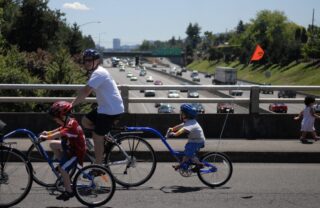
(Photo: Jonathan Maus/BikePortland)
Like dreaded vegetables on a dinner plate, the powerful Joint Transportation Committee of the Oregon legislature has left the hardest stuff to swallow until the very end. At their last meeting of the session Thursday morning, committee members are likely to vote on consequential legislation that would set funding levels for three freeway projects and a plan to allow the state to borrow up to $600 million in tolling-backed bonds.
Months of debate have focused on two bills in the House: 3055 and 3065. Both are omnibus bills (meaning they deal with many issues) and look to tweak House Bill 2017, the landmark $5.2 billion package of project earmarks and new taxes the legislature passed in 2017. Among other things, HB 2017 set aside $30 million per year for the I-5 Rose Quarter project (to begin January 2022) and it directed the Oregon Transportation Commission (the governor-appointed body that manages the Oregon Department of Transportation) to study and implement tolls on sections of I-5 and I-205 in the Portland region.
Advertisement
House Bill 3055’s 109-pages address everything from the disabled placard program to a tweak to the definition of bicycle. It also includes an important section on changes to the state’s congestion pricing/tolling policies. Early versions of the bill clearly showed ODOT’s intent to change the intention of HB 2017 away from demand management and toward revenue generation. It would have changed the name of the program from “value pricing” to “tolling” and the fund from “congestion relief fund” to “toll program fund.” Concerns around these changes were captured by veteran transit advocate and retired TriMet employee Doug Allen in testimony submitted to the Joint Transportation Committee on March 15th:
Tolling cannot serve two masters. If it is to pay for bonded construction projects, tolls will be high, be in effect all day, cause inefficient utilization of highway capacity, and cause diversion. Public acceptance of these high tolls seems dubious. The revenue is unavailable for transit and safety projects on adjacent roadways.
If tolls are designed to solve congestion, they can be much lower, meaning that they are more equitable for low income travelers. They can be reduced to zero outside the peak. Revenue can be used to construct sidewalks, transit lanes, bicycle lanes, safe pedestrian crossings, etc. Public acceptance is much more likely. Highway capacity is efficiently utilized.
This tension — between using pricing to change behaviors versus using it to raise money to build more freeways — still exists; but because of strong pushback from advocates and regional government stakeholders, the bill language has changed for the better.
HB 3065 raised eyebrows when it emerged in March due to its chief backer, House Speaker Tina Kotek. It seeks to fund a pricing/tolling program, issue bonds off the proceeds to create new project revenue, and spread that $30 million per year for I-5 Rose Quarter to two other regional freeway projects: I-205 Stafford Road to OR-213 and the I-5 Boone Bridge and Seismic Improvement.
Advertisement
Initial versions of HB 3065 raised considerable ire due to what many thought was a blatant attempt to use tolling to build more, wider freeways. The bill was strongly opposed by groups as varied as No More Freeways (who called it “Tina Kotek’s highway widening slush fund”) and the City of Portland Bureau of Transportation, who issued a press release laying out their concerns. This pushback has led to amendments that sources say has improved the language (and its potential outcomes), but the bill is still a source of consternation for anti-freeway advocates because of its intention to direct money toward projects that will encourage more driving. Among its provisions is language that would allow ODOT to increase its borrowing limit to pay for freeway projects (via tolling bonds) from $100 to $600 million.
Despite the end of the legislative session looming and time running out at the Joint Transportation Committee, much of the dust on these two bills has yet to settle. Traditional tensions around distrust of ODOT and status-quo-beholden lawmakers loom. And the split between groups who see pricing as a tool to manage demand and fund active transportation projects and/or orphan highway updates, versus those who think the only solution to “bottlenecks” is a wider bottle, remain.
Today’s work session starts at 8:00 am. Before lawmakers debate these bills, they’ll hear an informational presentation on Metro’s Regional Congestion Pricing Study. Details of the meeting and a link to the video here.
Stay tuned.
[For more on where this debate stands see the excellent story just published on OPB.]
— Jonathan Maus: (503) 706-8804, @jonathan_maus on Twitter and jonathan@bikeportland.org
— Get our headlines delivered to your inbox.
— Support this independent community media outlet with a one-time contribution or monthly subscription.


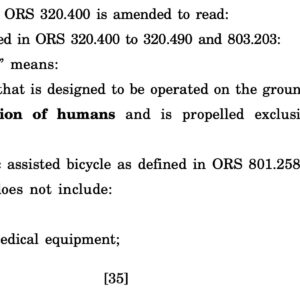
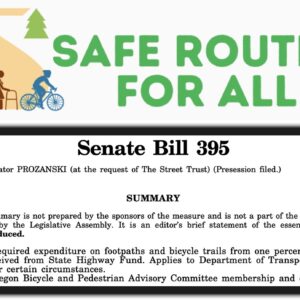
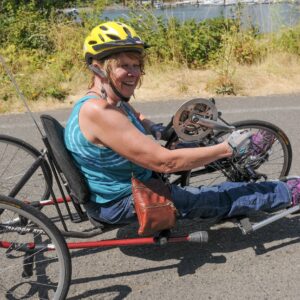
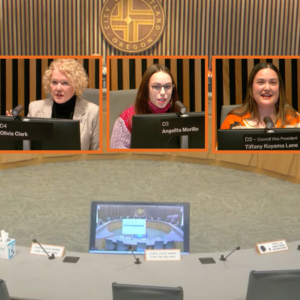
Thanks for reading.
BikePortland has served this community with independent community journalism since 2005. We rely on subscriptions from readers like you to survive. Your financial support is vital in keeping this valuable resource alive and well.
Please subscribe today to strengthen and expand our work.
It would be best if we can hold off these boondoggles before the “Big One” ends them for us. Can’t see spending the money and going through the agony only to have everything obliterated at some point after they’re built.
You’re going to die anyway, why bother with an annual physical exam or taking blood pressure meds?
Thanks for following the money. People who want greener transport should make allies with proponents of smaller government. If ODOT doesn’t give a whiff about climate change, it’s time to shrink it to the size it can be drowned in the bathtub.
The thing that I find really depressing about the freeway fight is that even if “no more freeways” is completely victorious, Portland’s GHG emissions will likely continue to increase for the foreseeable future. For example, I’m not aware of any org/group fighting to limit the largest and fastest-growing source of Portland’s GHG emissions: consumption of things not produced in Portland. In fact, consumption-based GHG emissions are such a disaster that Portland has reneged on its C40 pledge to track and address these emissions (kinda reminiscent of the failed CAP and 2030 bike plan, eh?).
The last and only time Portland actually tracked consumption-based emissions was in the 2015 CAP where they reported that exported consumption GHG emissions were 9.4 million tons while transportation emissions were only ~2.8 million tons.
Let me repeat for impact:
Exported consumption emissions: 9.4 million
Conventional transportation emissions: 2.8 million
https://www.portland.gov/sites/default/files/2019-07/cap-2015_june30-2015_web_0.pdf
The state of Oregon continues to track consumption-based emissions and these have been increasing at a much faster pace than transportation emissions so this is almost certainly true for Portland (given that most of OR’s consumption based emissions come from the Portland area).
PS:
Portland pledged to track and address its consumption-based emissions according to C40 Climate Action Planning methodologies:
https://resourcecentre.c40.org/resources/reducing-ghg-emissions
PPS: Only ~60% of Oregon’s transportation emissions come from non-commercial SUV/truck/cage use and much of the recent increase in emissions comes from aviation and shipping.
I feel that depression too – and not just with regards to this specific issue.
It feels like the parameters of the climate debate more broadly are such that we have to fight tooth and nail for even the most piecemeal and unambitious of emissions reductions. And even if we win the fights being had right now, many of which we will not due to the intransigence and indifference of people and institutions, we’re still looking down the barrel of a climate catastrophe of apocalyptic proportions.
It’s really sad and makes it hard to stay motivated/activated when the odds seem so stacked against the continued long term existence of a thriving human population.
“we have to fight tooth and nail for even the most piecemeal and unambitious of emissions reductions”
This was what I was trying to communicate but I’d go a little further. Even if every single freeway project is frozen this does not entail a reduction in transportation emissions (especially over the next decade or so).
The elephant in the room is the need for a war against “the status quo”. This kind of systemic change can only develop from a mass movement but localist environmentalism — where the focus is blocking a single methane conduit or freeway project — remains the dominant form of organizing. To me it often seems as if the magnitude of the crisis is enabling a perverse form of political retreat.
Climate modeling suggests that people in northern areas will be the least affected. One of multiple published examples:
The bottom panel is the standard deviation of the year-round climate anomaly in year 2100.
https://advances.sciencemag.org/content/4/5/eaar5809
It’s conceivable that economically comfortable people in Portland will continue to thrive while the futures of many living closer to the equator will be decimated.
I watched Metro’s presentation and I was really impressed and excited about what is now coming out the Metro Transport Modelling group. They GET IT!. Thank you Metro President Lynne Peterson. Your team did a fantastic job of pulling together a congestion pricing package. I wasn’t able to finish the whole presentation, but it looks like the right start.
It really is an odd duck piece of legislation if the Senate President Courtney has to sit on a sub-board to get it to pass. The last time I saw him sit on a lower committee like that, to get HB 2020 out of Ways and Means President, Courtney yanked Sen. Betsy Johnson off the committee for one vote. And then the entire Senate walked out. He couldn’t get the regular committee to pass it. Again, Senate President Courtney would rather risk another walk out to pay for these freeways.
We gave Senate President Courtney the Salem capitol rebuild or remodel, last year. He banged his hands around for that like a white entitled statesmen used to getting his way. I thought he was going to retire or something? He wasn’t supposed to keep wreaking havoc on Portland transport system, he’s not even from Portland. Salem politicians are trying to retain control of the money and ODOT for their own pet projects.
I hope House Speaker Kotek sits on this bill to give Metro a chance to push out a program that will actually work. I think it’s quite pathetic, what the Democrats are doing in Salem. It’s not social justice reform right now. It’s pork barreling.